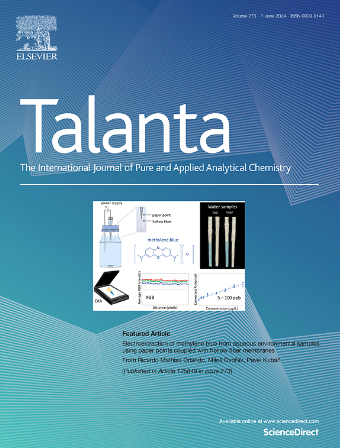A novel separated OPECT aptasensor based on MOF-derived BiVO4/Bi2S3 type-II heterojunction for rapid detection of bacterial quorum sensing signal molecules
IF 5.6
1区 化学
Q1 CHEMISTRY, ANALYTICAL
引用次数: 0
Abstract
Quorum sensing signal molecules released by microorganisms serve as critical biomarkers regulating the attachment and aggregation of marine microbes on engineered surfaces. Hence, the development of efficient and convenient methods for detecting quorum sensing signal molecules is crucial for monitoring and controlling the formation and development of marine biofouling. Advanced optoelectronic technologies offer increased opportunities and methods for detecting quorum sensing signal molecules, thereby enhancing the accuracy and efficiency of detection. This study proposes a CAU-17-derived BiVO4/Bi2S3 gated organic photoelectrochemical transistor (OPECT), and applies it to the detection of a typical quorum sensing signal molecule, N-(3-oxodecanoyl)-l-homoserine lactone (3-O-C10-HL). A strategy of signal amplification and separate detection process was employed. Specifically, BiVO4/Bi2S3 type-II heterojunction photoanode was fabricated and successfully utilized for effective gating of the poly (ethylene dioxythiophene): poly (styrene sulfonate) channel. Using the previously screened 3-O-C10-HL adaptor, rapid and sensitive recognition of 3-O-C10-HL was achieved by effectively enhancing the response of the photoanode and regulating the overall performance of the device. The designed device demonstrated excellent specificity and sensitivity with a detection limit of 2.85 pM. This work not only provides an effective OPECT biosensing approach for detecting 3-O-C10-HL, but also reveals the application potential of semiconductor MOFs-derived materials in future optoelectronics.

求助全文
约1分钟内获得全文
求助全文
来源期刊

Talanta
化学-分析化学
CiteScore
12.30
自引率
4.90%
发文量
861
审稿时长
29 days
期刊介绍:
Talanta provides a forum for the publication of original research papers, short communications, and critical reviews in all branches of pure and applied analytical chemistry. Papers are evaluated based on established guidelines, including the fundamental nature of the study, scientific novelty, substantial improvement or advantage over existing technology or methods, and demonstrated analytical applicability. Original research papers on fundamental studies, and on novel sensor and instrumentation developments, are encouraged. Novel or improved applications in areas such as clinical and biological chemistry, environmental analysis, geochemistry, materials science and engineering, and analytical platforms for omics development are welcome.
Analytical performance of methods should be determined, including interference and matrix effects, and methods should be validated by comparison with a standard method, or analysis of a certified reference material. Simple spiking recoveries may not be sufficient. The developed method should especially comprise information on selectivity, sensitivity, detection limits, accuracy, and reliability. However, applying official validation or robustness studies to a routine method or technique does not necessarily constitute novelty. Proper statistical treatment of the data should be provided. Relevant literature should be cited, including related publications by the authors, and authors should discuss how their proposed methodology compares with previously reported methods.
 求助内容:
求助内容: 应助结果提醒方式:
应助结果提醒方式:


